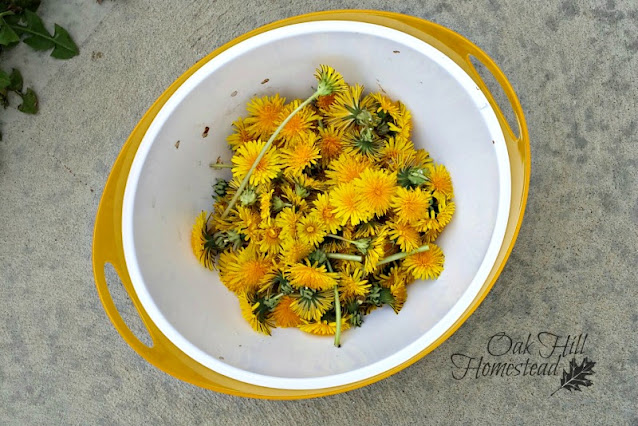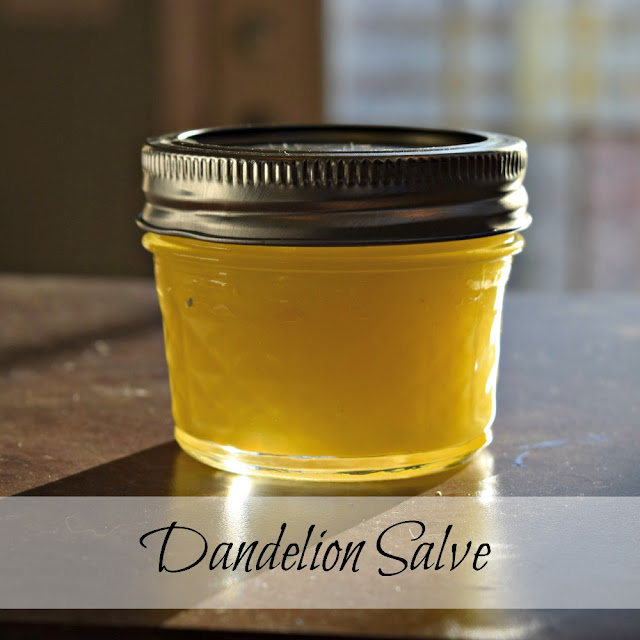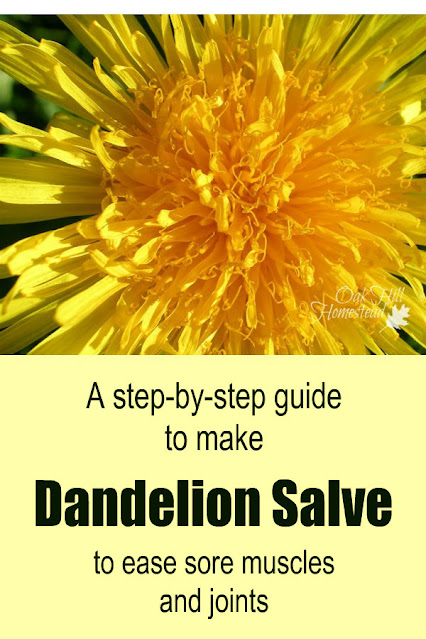DIY dandelion salve
This post was last updated in April 2024.
I remember my dad on his hands and knees in the front yard, digging up dandelions by the roots.
And I remember watching our neighbors when we lived in Greece, foraging for dandelions in early spring, the first wild greens of the year.
Of the two, I have always been more like our former neighbors. Although I don't eat the greens, the cheerful yellow flowers have always made me smile.
From grubby toddler hands offering me a yellow bouquet to the white "blow flowers" that my children loved, dandelions have given me some sweet memories.

Dandelion salve benefits
When our middle daughter complained about all the dandelions in her front lawn a couple years ago, I said "eat 'em!" She wasn't interested in that, but when I suggested making dandelion salve she was hooked.
Dandelion-infused oil can be used as a pain-relieving massage oil or made into salve, soothing such conditions as stiff necks, sinus headaches, sore back muscles and arthritic joints.
It also helps to heal sores and conditions rough, dry skin.
My hands are so dry from gardening and working outside, and I really wanted to try this natural remedy. But because my dogs have access to our front yard, I don't use the dandelions that grow there. (Ewww. If you know, you know!)
I made her a deal: if she picked the flowers, I'd tell her how to infuse them in oil and when I visited later in the year, we'd make the salve together.
So she sent Granddaughter out to pick all the yellow blooms that afternoon and again the next morning.
They removed the green part of the flowers, put the yellow petals in a dry jar and poured enough olive oil in the jar to cover the flowers.
Then she put the jar on the kitchen counter and let it infuse until I visited them that summer, shaking it once in a while when she remembered.
Dry or wilt the dandelions
Herbalists recommend letting plant material dry out before infusing in oils, so let your dandelion flowers rest on a towel for several hours or overnight until they are pretty well dry.
You could put them in your dehydrator for several hours instead.
Moisture can cause your infused oils to mold or go rancid, so using a dry jar and dried-out plants is the way to go.
Of course, you'll want to use dandelion flowers that haven't been sprayed or treated with chemicals.
(And, um, that's why I don't use dandelion flowers from my own yard because my dogs roam that area. You know what I mean, right?)
Infuse the dandelions in oil
The first step is to infuse the dandelions in oil.
I've written in more detail about infusing herbs in oil here.
Even though I made those particular oils to use in soap making, the infusing process is the same - so hop over and read that post if you need directions on how to infuse oils.
Don't worry, it's super easy.
How to make dandelion salve
Here is how we made our salve. (For step-by-step directions, scroll down to the bottom of this post.)
By the time I visited my daughter in the summer, the oil had been infusing for six weeks, a perfect amount of time. Our next step was to strain the petals from the oil.
I prefer to use muslin to strain infused oil, so that I can squeeze the last drop of the oil from the plant material, but I hadn't thought to bring some. I tried paper towels but they tore too easily, so I finally used a wire strainer.
The strainer separated most of the oil from the dandelion petals, but we did lose a bit of oil since we couldn't squeeze out the very last drops. An old handkerchief or an old, clean t-shirt can be used instead of muslin.
Our strained oil was such a pretty yellow color after infusing for more than six weeks.
I measured out the beeswax that I'd brought with me, using 1/4 cup of beeswax and just under two cups of oil. I added a 1/4 cup of coconut oil too, to make the salve softer and less waxy. I guess it's more the consistency of ointment, actually.
Omit the coconut oil if you want a stiffer salve.
Putting the beeswax in a glass measuring cup, we melted it by setting the measuring cup in a saucepan of simmering water on the stove like a double boiler. Next we added the coconut oil and let it liquify.
I added the infused olive oil to the beeswax slowly, stirring after each addition because the room-temperature infused oil cooled the beeswax a bit.
Then we poured the hot salve into six 4-ounce canning jars. The last jar wasn't quite full, so it was the jar we used first.
Once it cooled and thickened, my daughter applied some to her sunburned shoulders and I rubbed it into my hands. It was so luxurious and soothing.
It's a bit oily when first applied, but it soaks in after just a few minutes.
I brought two-and-a-half jars home with me and she kept three for herself.
Dandelion salve recipe
Here is the step-by-step version:
- Pick dandelion flowers and remove the green part. Let the flowers rest until they are dry before continuing on to the next step, or put them in your dehydrator on a low temperature for a few hours.
- Put the yellow flowers in a dry jar and cover with olive oil so that the flowers are completely submerged.
- Let your oil and dandelion flowers infuse for several weeks - at least four weeks is a good length of time. Gently shake or swirl the jar once in awhile.
- Strain the oil through a cloth; muslin works well. Squeeze out every last drop of oil. Discard the spent flowers.
- Melt beeswax in a double boiler. Add coconut oil if desired (you can use beeswax only if you wish, it will have a stiffer consistency but will still have all those great soothing qualities).
- Once melted, remove the beeswax from the stove and slowly add the infused dandelion oil, stirring as you go so it's well-distributed before it cools.
- Pour into containers such as 4-ounce canning jars. Let cool, and add the lids.
Massage the salve into your skin. Dandelion salve soothes achy, tired muscles, chapped skin, and has anti-inflammatory properties that will help ease the pain of sore joints and arthritis.
How do you feel about dandelions? Do you love 'em or hate 'em? Make this salve and share it with your friends! They'll thank you for it, and they might even share the dandelions in their yards with you too.
For more simple, healthy living ideas and inspiration, subscribe to The Acorn, Oak Hill Homestead's weekly-ish newsletter, and join me on Facebook, Instagram and Pinterest. I'd love to see you there!























